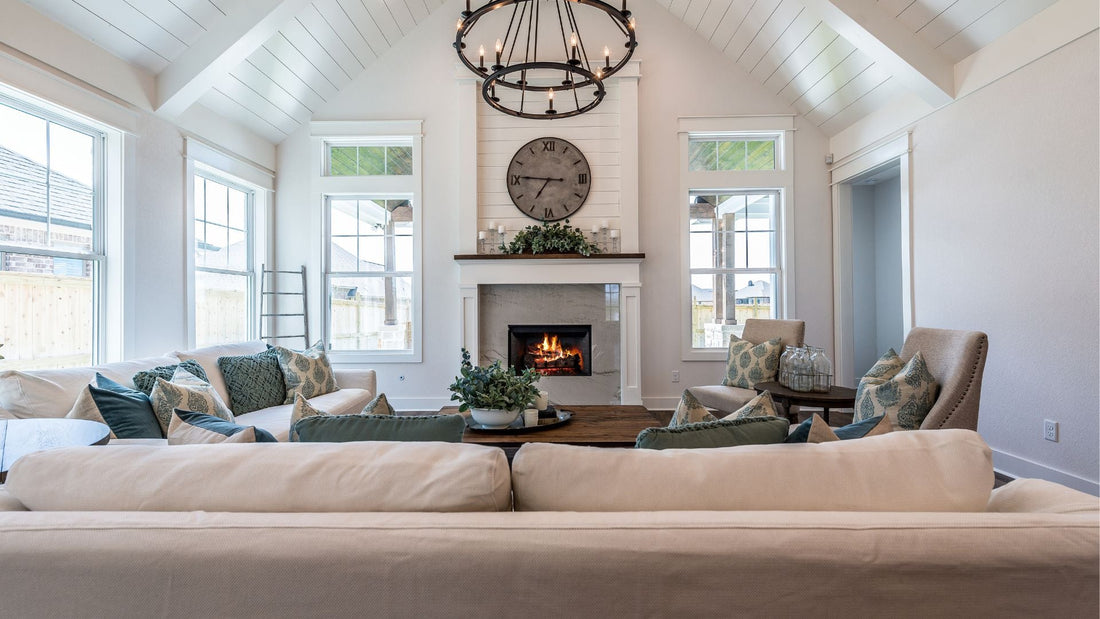Due to the way that Cathedral or Vaulted ceilings are often built, they can pose challenges to roof ventilation. In order for me to outline these unique roof ventilation challenges, it may be easiest for me to start by explaining a typical home attic and the methods used for roof ventilation. In a typical slope roofed home, it is common that the attic area would be a simple wide open space. From a roof ventilation point of view, a wide open attic area is very simple to ventilate. Typically, the insulation would be installed in the attic floor. Years ago, the builder would install louvered sidewall vents at each gable end wall and the wind would simply blow into one vent and exit from the other creating the necessary air movement. Since then, it has become more common to install a ridge vent and soffit vents as the primary roof ventilation. The point is, in order to attempt to keep the home cooler, avoid ice jams and ice back-ups, and to eliminate the build-up of moisture and condensation, every square foot of the underside of the roof area must be ventilated. By ventilating properly, you are assuring that ambient external air is entering the home through an intake vent (usually a soffit vent), venting the entire underside of the roof area, and leaving through an exit vent. By properly venting, you are assuring that the air under the roof sheathing is at equilibrium with the outdoor air thereby eliminating any temperature or humidity gradient and allowing the assembly to remain cool and dry. When you place a glass of ice-water on a wood table on a hot summer day, the glass becomes dripping with condensation. That same wetness occurs within roof systems when the home’s internal heat meets the cold nails in the winter, and ventilation is necessary to remove that moisture and avoid a residual build-up.
Inadequate Roof Ventilation Causes Moisture Buildup
People mostly pay attention to roof ventilation because they want to cool the attic, but the main purpose of roof ventilation is to eliminate condensation and moisture build-up. So with a typical wide-open attic space which normally contains the insulation envelope in the attic floor, providing roof ventilation is not very complicated because each area of the attic is open-to or “breathes” with the rest of the attic; so as long as that area has an adequate intake and exhaust vent, it will function properly. However, if you add a vaulted or cathedral ceiling to the design, the ventilation requirements become much more specific.

Not Enough Roof Ventilation Causes Ice Dams
When ventilation is inadequate, a buildup of moisture and eventually wetness is not the only negative repercussion resulting. Roof ventilation must also be adequate for heat loss during winter for buildings in northern climate. The proper balance of ventilation for heat loss must be achieved, or else you can have a buildup of ice on the roof areas above outside walls due to the fact that most heat loss would be immediately above a heated outside wall; this higher concentration of heat loss must be vented or else cycles of melting and freezing can occur creating a lump of ice that can back up into the building; often referred to as a "ice dam" or "ice Jam". Most metal gutter guards are the first to freeze and can exacerbate ice dams. It is helpful, of course , when they melt naturally but we can also assist in ice melting by using electric ice melting wires as well as many made assistance to the sunshine. We can add an item that is black and extends to absorb the sun and add natural melting. See how this gutter guard insert extends with a black raised bristle profile which absorbs the sun and add warmth to aid gutter ice melting.
Add Electric Wires to Melt Gutter Ice: and add Sunshine
If the ice is overwhelming, for many years people have successfully purchased electric heat tapes aka electric ice melting wires which are great for actively melting the gutter ice. They run through the gutter and melt gutter ice, but of course you have to pay for the electricity so you only use them when you need them and you do not just leave them on all winter.
De-Icing Cables, TIP - Save Electricity, Invite More Sunshine
To save electricity on gutter ice melting de-icing cables, just also fill the whole gutter with 3 foot lengths of GutterBrush because the black bristles stop snow clogging but also extend out the top of the gutter and with the black surface they absorb warmth from the sun which adds to quicker ice melting naturally, passively and with no electric bill. This helps decrease how often and how long you need to turn on the de-icing cables; which saves energy. GutterBrush is compatible with ice melting cables and has been used in this regard for more than 20 years. This easy to install black brush gutter guard actually alleviates and decreases gutter ice by decreasing snow congestion and improving melting flow. Click here to see how inadequate roof ventilation and resulting ice dams can be able to be alleviated by the winter benefits of this simple brush gutter guard .
To Alleviate Gutter Ice Use GutterBrush with or without ice melting wires.
Below is a picture of GutterBrush in the gutter as well as a picture that shows how easy it is for anyone to install. You can click the picture to learn more about this simple technique to decrease gutter ice.
Proper Roof Venting For Each Rafter Bay
Most Cathedral or Vaulted ceilings are built by simply extending the living area of the room up into the attic and applying the ceiling Sheetrock or plaster to the underside of the roof rafters. When built in this manner, the room in question enjoys a very nice tall sloped beautiful ceiling. The point is that the roof rafters have already been built, why not use them to also create and support the ceiling? Many builders will simply install the roof insulation between the cathedral ceiling roof rafters and then cover it up by installing the Sheetrock or the plaster ceiling right against the underside of those sloped roof rafters. Structurally, this makes sense, but as soon as you insulate between the rafters and install the ceiling, you are changing the roof ventilation requirements. In the wide open attic scenario, the underside of the roofing is a continuous open area and is capable of breathing as one unit, however as soon as someone installs the roof insulation between the rafters, it adds the absolute requirement that a ridge vent and soffit vents must be used. In the open attic scenario the insulation envelope is in the floor of the attic. As soon as someone installs a sloped ceiling up against the rafters, they are changing the insulation envelope from being in the floor of the attic to its new location above the ceiling and below the roof sheathing. Every square foot of roof area must be ventilated on the outer side of the insulation envelope, therefore when you install the insulation between the rafters, you now have the requirement of creating ventilation air movement within each of the rafter bays. The normal wide open attic area is easily vented because it is one wide-open area so each square foot breathes to every other square foot of area, but due to the fact that the vaulted ceiling is installed up against the rafters, now each rafter bay becomes its own area with requirements of ventilation air movement; because each rafter bay can not breathe laterally to the next rafter bay. The rafters block the lateral ventilation and air movement. Therefore, in order to achieve air movement and adequate ventilation, each rafter bay must be assured to be individually ventilated with its own intake and exhaust.
Cathedral Celiling Roof Vent
Typically, you can achieve each individual rafter bay ventilation by installing soffit vents and a continuous ridge vent. The ridge vent allows ventilation air to exit from every linear foot of the roof’s ridge while the soffit vents allow ventilation intake into every rafter bay. By venting the entire ridge continuously as well as the entire soffit, you have assured that fresh ventilation air movement will be achieved at every square foot of space within the cathedral ceiling. One further complication that can stop air movement is caused if the installer does not additionally leave at least one full inch of air space on the outer side of the insulation envelope, beneath the roof sheathing. Inspecting for such an air space is difficult, because the inspector typically can not view within the ceiling. Even though a ridge vent and soffit vents may be installed, problems can occur if the insulation is packed tightly up against the underside of the roof sheathing and not allowing the air to move freely from intake to exhaust, then the assembly may not be properly ventilated and can possibly be susceptible to damage from condensation issues, moisture build-up , wetness, bugs, and rotted wood. Ice jams and ice backups are also frequently caused by insufficient roof ventilation as well as gutter guards that cause a “first to freeze” area at the lower edge of the roof. Click here to see a simple gutter guard product that does not involve the roof.
Cathedral Ceiling Changes Attic Configuration
The Cathedral or Vaulted ceiling changes the configuration of the attic, insulation envelope, and roof ventilation. A typical wide-open attic is simple to ventilate because each area can breathe laterally to each other area. As soon as the ceiling is installed up against the roof rafters, each rafter bay becomes a separate area requiring its own air movement and ventilation, because it can not breathe laterally. Each rafter bay requires its own intake as well as exhaust vent and the assurance that the air has space to move above the insulation envelope. When each rafter bay is provided with an adequate amount of fresh air flow, the roof will function properly and stay dry.
Alex O’Hanley
alex@gutterbrush.com
GutterBrush since 2017, prior - 25 Years Roofing





